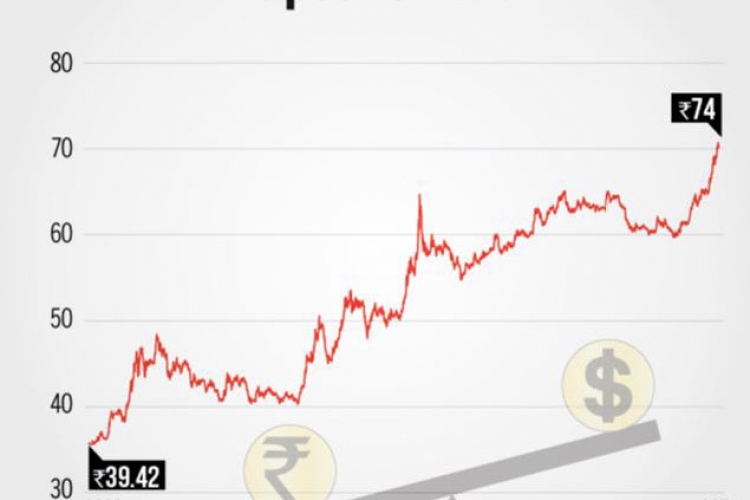Rupee depreciation : RUPEE AT 73.5 TO US$ , WHAT'S HAPPENING ?
What is Depreciation?
Currency depreciation is the loss of value of a country's currency with respect to one or more foreign reference currencies.
Value of the rupee has changed from Rs 17.50 per dollar in 1990 to Rs 74 today. With reforms launched in 1991, RBI adopted a ‘flexible exchange rate system’ with the RBI intervening in the foreign exchange market only to smooth out short-term fluctuations.This depreciation has been crucial for maintaining both overall macroeconomic stability and robust growth during these years.
CURRENCY EXCHANGE RATE SYSTEM:
A floating exchange rate(flexible) is a regime where the currency price is set by the forex market based on supply and demand compared with other currencies. This is in contrast to a fixed exchange rate, in which the government entirely or predominantly determines the rate.
Eg. Increased demand for rupee in foreign exchange market will lead to increase in value of rupee.
Why present fall in value of rupee ?
Nevertheless, to understand the recent episode of rupee depreciation and why this depreciation became necessary, begin by noting that the post-1991 opening up of our capital account was initially limited to foreign direct investment (FDI) and equity investment. But this changed in recent years with the government opening the door wider and wider to financial capital flows. These flows are far more liquid than FDI and equity investments and can enter and exit the country fast in response to changes in interest rates abroad.
Following the 2008 global financial crisis, interest rates in the United States progressively fell, leading foreign investors to move more and more funds into India. Since these funds helped keep the interest rate on the government debt low, the government found it attractive to progressively liberalise the cap on them. In parallel, Indian corporates also sought and got progressively greater access to lower-interest external commercial borrowings (ECBs).
As long as interest rates in the United States remained low, these capital inflows produced a happy outcome for the government, foreign investors investing in Indian debt and Indian corporates borrowing abroad. Steady inflows of capital also kept the rupee from depreciating, which ensured high dollar returns to foreign investors and low rupee cost of servicing ECBs for Indian corporates.
But an upward turn in the interest rates in the United States recently jolted this happy equilibrium. Not only did the availability of foreign financial capital suddenly dry up, several years of accumulated investment in Indian debt sought to exit. Foreign institutions that could recall loans given to Indian corporates did so as well. Some foreign investors in Indian equities also sought exit to earn the higher interest rates at home.
These exits required the conversion of massive volumes of rupees into dollars over a short period. That put downward pressure on the value of the rupee. The only way that RBI could have maintained the original value of the rupee was by selling as many dollars from its reserves as demanded by exiting investors at the original exchange rate.
Such defence would have been unwise for two reasons.
1. The depreciation discouraged exits by effectively increasing the cost of converting rupees into dollars, a stable rupee would have led to much larger exits, heavily depleting RBI’s foreign exchange reserves.
2.With private actors instead of RBI supplying dollars to exiting investors, dollars available for imports shrank. That forced much needed adjustment in the current account by reducing the import bill.
One other reason for the dip in rupee is rise in oil prices from it's years of slowdown. In the absence oil price hike, the rupee depreciation would have been less but not by a wide margin.


 IAS-2026 - OPTIONAL / GEOGRAPHY / PUBLIC ADMINISTRATION / SOCIOLOGY / ANTHROPOLOGY / ORIENTATION ON 03 & 04-10-2025
IAS-2026 - OPTIONAL / GEOGRAPHY / PUBLIC ADMINISTRATION / SOCIOLOGY / ANTHROPOLOGY / ORIENTATION ON 03 & 04-10-2025 